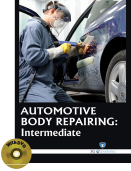Trade and Industrial Education

Automotive Body Repairing: Intermediate comprehends various diverse practical and visual skills with knowledge of specialized materials and techniques. An auto mechanic is a mechanic with a variety of automobile makes or either in a specific area or in a specific make of automobile. In repairing cars, their main role is to diagnose the problem accurately and quickly. They often have to quote prices for their customers before commencing work or after partial disassembly for inspection. Their job may involve the repair of a specific part or the replacement of one or more parts as assemblies. This book will introduce the knowledge and skills for those studying and/or working in automotive industry to interpret and convey information in response to workplace requirements.
About this Book
The information in this book consists of competencies that a person must achieve in repairing automotive bodies and panels of light and heavy duty vehicles according to manufacturer’s specification manuals using hand and power tools and welding equipment. It includes the competency in planning and preparing job activities prior to repairing body panels ; dismantling automotive accessories, disassembling, cleaning and inspecting of parts to be repaired; performing basic benchwork (such as layout, cutting and filing, drilling, tapping) body panel alignment and applying of anti-corrosion.
About the Automotive Industry
An automotive body worker remove fixable dents, replace parts damaged beyond correction, and straighten out bent bodies. Vehicles with damaged frames or sections can be worked on by automotive body repairers with special equipment. Repairers use alignment machines powered by hydraulic pressure to realign damaged parts of the vehicle. Some vehicles are designed without frames, known as “unibody” vehicles and they have to be realigned precisely to factory settings to work again. By relying on benchmark systems, repairers can accurately measure each portion of the body to assess how far out of alignment it is before using the alignment machines to move it back to its original position. Portions of the body panels that are extremely damaged will be extracted by body repairers with a pneumatic metal-cutting gun and then new sections must be welded in to replace the old section. Minor dents can be removed through the use of hand tools and pneumatic hammers, or by using a hydraulic jack or hand prying bar. A small anvil can be used to smoothen out smaller dents and creases by placing it on one side of the damaged metal and hammering it on the other side. A process known as metal finishing can be used to extract small pits and dimples through the use of pick hammers and punches. Employment as an automotive body repairer is projected to increase nearly at the same pace as the average for all occupations. Most of the job openings will come from retirements and repairers who move to other areas of work. Those with formal training in automotive body repair and mechanics have the best opportunities before them. As the amount of vehicles grows in conjunction with population growth, so to will the demand for body repairers. As more and more vehicles on used, the total number of accidents will increase. Newer vehicles are made of materials that are harder to work with, such as steel alloys, aluminum, and plastics. Thus, repair will be more time consuming, as newer designs in vehicles, specifically light weight vehicles, makes them susceptible to greater damage.